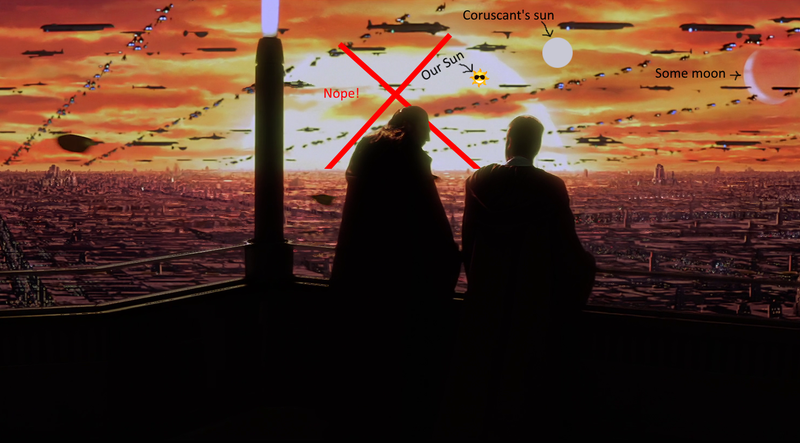File:Coruscantsunset.png

Original file (1,475 × 816 pixels, file size: 1.4 MB, MIME type: image/png)
Calculations
(1) Small-Angle Formula: D = θ d / 206,265 arcseconds, where the number of arcseconds in a circle divided by 2π = 206,265
D = linear size of an object
θ = angular size of the object, in arcseconds
1° = 60 arcminutes = 3600 arcseconds
d = distance to the object
Angular size of our Sun
(1) D = θ d / 206,265
Linear size of our Sun = 1,391,400 km
1,391,400 km = θ (150,000,000 km / 206,265 arcsec)
θ = 1,391,400 km / (150,000,000 km / 206,265 arcsec) = 1,913.31 arcsec = 0.53° ≈ about the size of a pea (6 mm or 0.23 in) from about two feet away.
Linear Size of Coruscant Prime
Here, we have to go to Legends to get an idea of what the answer should be. They describe Coruscant’s sun as blue-white in color1. To be that color, the sun would have to be between 3.6 and 13.2 solar radii (R☉) in diameter (for reference, our sun is 2 R☉ wide)2. So let’s just take the average for Coruscant Prime, and call it 8.4 R☉
(2) 1 R☉ = 695,700 km
8.4 R☉ x 695,700 km/ R☉ = 5,707,800 km wide, or about 4 times the size of our sun (so not tiny!)
Angular Size of Coruscant Prime
(1) D = θ d / 206,265 arcsec
5,707,800 km = θ x 229,000,000 km3 / 206,265 arcsec
θ = 5,707,800 km / (229,000,000 km / 206,265 arcsec) = 5,141.13 arcsec = 1.428° ≈ somewhere between the size of a quarter and a nickel held at arm's length, so it would appear larger than our sun, but not by too much.
Brightness
BUT, if Coruscant was a type B (blue white) star, that would make it 25-30 thousand times brighter than our sun (a class G star). Since it's farther away, Coruscant wouldn't receive the full force of that luminosity4, but since intensity of sunlight follows the inverse-square law, and since Coruscant is 1.53 times farther from its sun than we are from ours, it would still be getting slammed with 11,700 times as much sunlight as the Earth (which gets about 1 kW per square meter per hour). You don't need to do the math to know that this would pretty much bake the flesh right off your bones.
...But just for the heck of it:
If every square meter of Coruscant got 11,700 kW per hour, then it would absorb the equivalent of the average US home's electricity usage for a year (10,812 kWH5) in just over 55 minutes, or the equivalent of a typical home's daily power usage (30 kWh6) every 9.2 seconds. Youch!
File history
Click on a date/time to view the file as it appeared at that time.
| Date/Time | Thumbnail | Dimensions | User | Comment | |
|---|---|---|---|---|---|
| current | 12:34, 3 February 2017 |  | 1,475 × 816 (1.4 MB) | Kabutton (talk | contribs) |
You cannot overwrite this file.
File usage
The following page uses this file: